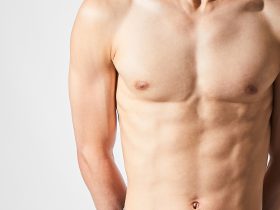 Many boys and men struggle with enlarged breasts and puffy nipples. Gynecomastia is a condition that causes the glandular tissue in males to overdevelop, creating the appearance of “man boobs.” Many pre-teens and teenage boys experience excess breast growth during puberty due to hormonal changes, but older men and newborn babies often have gynecomastia, too. Enlarged male breasts can cause embarrassment and may affect your quality of life, leading to nipple tenderness, psychosocial discomfort, and anxiety. Our Ivy-league trained plastic surgeon, John Kim, M.D., offers gynecomastia surgery, or male breast reduction.
Many boys and men struggle with enlarged breasts and puffy nipples. Gynecomastia is a condition that causes the glandular tissue in males to overdevelop, creating the appearance of “man boobs.” Many pre-teens and teenage boys experience excess breast growth during puberty due to hormonal changes, but older men and newborn babies often have gynecomastia, too. Enlarged male breasts can cause embarrassment and may affect your quality of life, leading to nipple tenderness, psychosocial discomfort, and anxiety. Our Ivy-league trained plastic surgeon, John Kim, M.D., offers gynecomastia surgery, or male breast reduction.
What Is Gynecomastia?
Boys and men with gynecomastia may notice a mound or lump of tissue that feels firm and tender under their nipples and areolas (darker pigment around the nipple). These lumps are benign and non-cancerous but often grow larger or unevenly. The disc-like tissue usually starts the size of a button, moves within the breasts, and is tender to the touch. Gynecomastia may cause these lumps in one or both breasts. At least 30% of men experience gynecomastia in their lifetime. While many of these cases resolve on their own, some men have ongoing concerns with enlarged male breasts, and gynecomastia surgery restores a masculine chest.
Gynecomastia symptoms include:
- Fatty tissue or palpable lump under the nipple that grows larger.
- Nipple soreness.
- Breast pain, especially in teenage patients.
- Enlarged nipples.
- Tender breasts.
Causes of Gynecomastia
Gynecomastia tends to develop due to hormonal changes, which is why teen boys often experience excess breast growth. However, other factors can influence hormone fluctuations, such as medication side effects from antidepressants, chemotherapy, cardiovascular drugs, antibiotics, and other pharmaceutical drugs. Illegal substances may also cause gynecomastia, including the use of anabolic steroids, marijuana, and heroin.
People with liver or kidney disease, pituitary or adrenal gland tumors, thyroid disorders, or lung or testicular cancers may be more likely to develop gynecomastia. Obesity is another cause, though the enlarged breasts may be due to fat accumulation, not breast growth (pseudogynecomastia).
Gynecomastia Correction
 Gynecomastia typically gets better on its own, but it may take up to three years after it develops. Treatment may start with discontinuing medications causing excessive breast growth or hormone therapy. Gynecomastia surgery offers permanent correction of “man boobs” with male breast reduction. The procedure removes the excess glandular tissue and skin and contours the chest for a flatter physique.
Gynecomastia typically gets better on its own, but it may take up to three years after it develops. Treatment may start with discontinuing medications causing excessive breast growth or hormone therapy. Gynecomastia surgery offers permanent correction of “man boobs” with male breast reduction. The procedure removes the excess glandular tissue and skin and contours the chest for a flatter physique.
Male breast reduction for gynecomastia requires general anesthesia or IV sedation. Our Harvard- and Stanford-trained plastic surgeon customizes gynecomastia surgery to your needs and may use one or both of these surgical techniques:
Liposuction for Gynecomastia Correction
Liposuction can address gynecomastia if the excess tissue is primarily fat. This method restores a flat chest by inserting a thin, hollow tube called a cannula through several tiny incisions. The cannula moves back and forth with a controlled motion to loosen the fat. Dr. Kim then suctions the fat cells out of the body. This method works well for pseudogynecomastia, but some patients may also need the excision technique for loose skin.
Tissue Excision for Gynecomastia Correction
Excision or surgical removal is best for men with excess glandular (breast) tissue and skin. The incision pattern depends on the patient’s needs and surgical preference but may require incisions around the areola to reduce or reposition the nipple-areolar complex. Dr. Kim removes the extra breast and skin tissue to create a more natural-looking male chest shape.
After gynecomastia surgery, you may have a compression garment or elastic bandage to minimize swelling and support your new chest shape. Dr. Kim may place a temporary drainage tube to remove blood or fluid build-up. Initial recovery from gynecomastia surgery takes about two weeks, but you will have activity limitations for up to six weeks. Most patients notice their gynecomastia surgery results within a few weeks as the swelling dissipates.
Candidates for Male Breast Reduction
Gynecomastia surgery candidates have enlarged male breasts that can’t be corrected with other medical treatments, such as discontinuing medications or drug use. You must be in good physical health with no medical concerns that may complicate the procedure and recovery, including no smoking or drug use.
It’s best for gynecomastia patients to have stable breast development. Adolescents may still qualify for gynecomastia surgery in some cases; however, they may need a second procedure if the breasts continue to overdevelop.
If you are at a normal weight and bothered by the excess breast tissue, you may qualify for male breast reduction.
Schedule Your Gynecomastia Surgery Consultation
If you struggle with “man boobs”, schedule a consultation at Northwestern Plastic & Reconstructive Surgery. Contact our board-certified plastic surgeon in Chicago, Illinois, at (312) 694-0879 or book your appointment online.
Gynecomastia Surgery FAQs
How do I know if I have gynecomastia or just excess fat (pseudogynecomastia)?
Gynecomastia involves glandular tissue, while pseudogynecomastia is caused by fat. Dr. Kim can determine the cause through a physical exam and tests.
Will gynecomastia come back after surgery?
In most cases, it does not return unless you experience significant hormonal changes, take certain medications, or gain weight.
How visible are the scars after male breast reduction?
Scars are typically small and discreet, often hidden in the natural contours of your chest.
Can gynecomastia surgery be combined with other cosmetic procedures?
Yes, it can be paired with liposuction or body contouring treatments for comprehensive results.
What tests are done to diagnose gynecomastia before surgery?
You may undergo blood tests to check hormone levels and imaging like ultrasound if needed.
Is gynecomastia surgery painful?
 You can expect some mild to moderate discomfort in the days following surgery, but it’s usually well-managed with prescribed medications. Most patients describe the sensation as soreness or tightness, which improves steadily during the first week. You should feel significantly better within a few days.
You can expect some mild to moderate discomfort in the days following surgery, but it’s usually well-managed with prescribed medications. Most patients describe the sensation as soreness or tightness, which improves steadily during the first week. You should feel significantly better within a few days.
What type of anesthesia is used for male breast reduction?
General anesthesia is typically used for your comfort and safety.
When can I return to work or exercise after gynecomastia surgery?
You can usually return to work in about a week and to physical activity in three to four weeks.
What should I avoid doing during recovery?
Avoid raising your arms above shoulder level, heavy lifting, and strenuous physical activity for the first few weeks. You should also steer clear of direct sun exposure to the incision sites, as this can affect scar healing. Wearing your compression garment as instructed is also essential for optimal results.
How should I prepare for gynecomastia surgery?
Before surgery, you’ll need to stop smoking and avoid alcohol and certain medications that can increase bleeding risks, such as aspirin or herbal supplements. Dr. Kim will give you specific pre-operative instructions tailored to your health profile to ensure a smooth surgical experience and recovery.
Are drains always used in gynecomastia surgery?
Drains are not always necessary. Dr. Kim will determine if they are required based on your case.
Will my chest look natural after surgery?
Yes, Dr. Kim’s precise technique ensures a contoured and masculine appearance.
How long do I need to wear a compression garment?
You’ll typically wear it for about four to six weeks.
Are there any non-surgical treatments that work for gynecomastia?
Some hormonal treatments may help, but surgery is the most effective option for permanent results.
Can adolescents undergo gynecomastia surgery safely?
Yes, if the condition has persisted for more than two years and is emotionally distressing, surgery may be appropriate.
What are the risks or complications of gynecomastia surgery?
As with any surgery, there are risks like infection, asymmetry, or changes in nipple sensation. These are rare when performed by a skilled surgeon.
How can I maintain my results long-term after surgery?
Stay active, eat a balanced diet, and avoid medications or substances known to cause gynecomastia.